#chemosynthesis
Text
Like, I know tube worms are worms. I know that. But.

I think actually they're Ahh! Real Monsters more than anything else, you know?

Giant tube worms are an iconic resident of hydrothermal vents. Hydrothermal vents are extremely cool, because they're one of the uncommon ecosystems that can survive independently from the sun!
Sure, lots of ecosystems live in the dark, but a lot of the food in those ecosystems, at their base, come from sunlight. Something at the surface consumes sunlight, makes energy, then dies and falls or gets eaten by something that swims downward, etc.
These giant tube worms are full of bacteria that are able to eat the chemicals that seep out from the nutrient-rich plumes created by the geology of hydrothermal vents. Basically, the seafloor has cracks, water falls into those cracks, the water gets super hot from the magma below, picks up minerals, then spews out in these different kinds of "plumes". Some are full of iron oxide and come out super dark (Black Smokers), whereas others, full of barium, calcium, and silicon are white (you guessed it, White Smokers). The tube worms live in communities with other deep sea weirdos like Yeti Crabs, clams, and many more.
Hydrothermal vents aren't the only places in the ocean where bacteria (sometimes paired with animals, sometimes on their own) make energy straight from chemicals, but they're probably the most iconic!
#Deep Sea#biology#Animal facts#Tube worms#Have you ever really looked at your worm man#Chemosynthesis
449 notes
·
View notes
Text
Wet Beast Wednesday: giant tube worms
You voted that I would talk about a worm and so I shall discuss the mighty giant tube worms. But first, we need to define what a tube worm is. This is another "no such thing as a fish" situation because there are actually a lot of different things we call tube worms. Turns out the "noodle in a tube" body plan is a pretty successful one. The worms I'm discussing today are members of Siboglinidae, a family of annelids (segmented worms) that was formerly classified as two different phyla until genetic evidence came in. I will primarily be talking about two species: Riftia pachyptila and Lamellibrachia luymesi, who have both adapted to distinct extreme environments in similar ways.

(Image ID: multiple patches of Riftia pachyptila growing from rock at a deep-sea hydrothermal vent. The worms are housed in long, white tubes, some stained yellow. Emerging from the tubes are respiratory organs covered in what appears to be red fur. End ID)
All members of Siboglinidae share a basic body plan consisting of a worm body inside of a mineral tube (side not, I think I will be including an orc or ogre named Sibog in my D&D campaign). The tube is composed of chitin and minerals and is secreted through glands along the body of the worm as it grows from larva to adult. The tube provides the worm within with protection from predators and environmental hazards while also providing support, allowing the worm to lift itself up into the water rather than remain on the substrate. The tube either connects to a solid object or is rooted in the sediment with extensions called roots. The roots are composed of the same material as the tube and can be considerably longer than the rest of the worm, though they are so fragile it is hard to study them. Since the worms often live in large congregations, their roots can twist together is massive mats called ropes. The inside of the tube is where you get into the squishy worm parts. The body of the worm is divided into four regions. The first of these regions I found many alternate names for while researching including cephalic lobe and branchial plume. I'm going to simplify and call it the plume because this segment is composed of one to 200 tentacles that are covered with feathery filaments that can make it look like the plume of a quill pen. The feathery portions of the plume are usually red because they are highly vascularized and filled with blood, similar to a fish's gils. The plume is used for respiration, taking in dissolved oxygen and (depending on the species) other dissolved gasses from the water. In most species, the plume is the only part of the body that extends from the tube. When in the presence of threats, the plume can withdraw into the tube, which can then be close with a structure called the obtraculum, similarly to the operculum found in many other invertebrates like snails. The second body region is the vestimentum. It has a winged shape and is composed of multiple bands of muscle. The vestimentum also contains the heart, a simple brain, and genital pores that release gametes. The third body region, which makes up most of the body, is the trunk. The trunk is the wormiest part of the worm and contains the gonads, the coelom (main body cavity), and the trophosome, which I will come back to later. The last body region is the opistosome, which connects the animal to the tube and is used to store and (maybe) excrete waste.
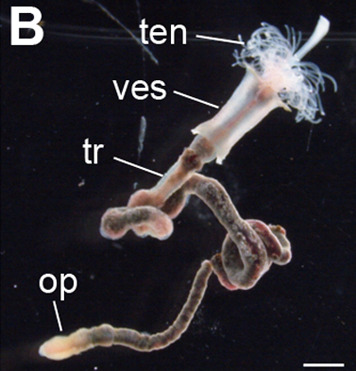
(Image ID: the tubeworm Lamellicrachia satsuma removed from its tube to show its anatomy. It has a plume made up of multiple feathery white tentacles, the vestimentum is a thick white section with flared tips, the trunk is long, brown, and wormlike, and ends with the yellowish opistosome. The body regions are labeled as "op" for opistosome, "tr" for trunk, "ves" for vestimentum, and "ten" for the plume. End ID. Source)
You'll notice that I didn't mention a digestive tract above. That's because these worms don't have one. Instead of a digestive tract, they have a trophosome, an organ composed of highly spongy tissue vascularized by two main blood vessels. Housed within the trophosome is a colony of bacteria that exists in a mutualistic symbiotic relationship with the worm. The worm provides the bacteria with a place to live and protection from predators while the bacteria provide the worm with all of its nutrition. The bacteria are all chemoautotrophs, gaining all their nutrition from chemical reactions using chemicals in their environment without needing to intake nutrients. In particular, they use oxygen, carbon dioxide, and hydrogen sulfide provided to them by the worm. The worm also provides other elements including nitrogen and phosphorus that the bacteria need. I'm going to be honest with you, I tried to comprehend the chemical reactions involved but it's been a long time since I took chemistry and I was never that good anyway so it's over my head. The short version is that the bacteria produces nutrients and chemicals (primarily carbohydrates and ATP) that it shares with the worm. Waste products are also sent into the worm's bloodstream and are sequestered at the opistosome.
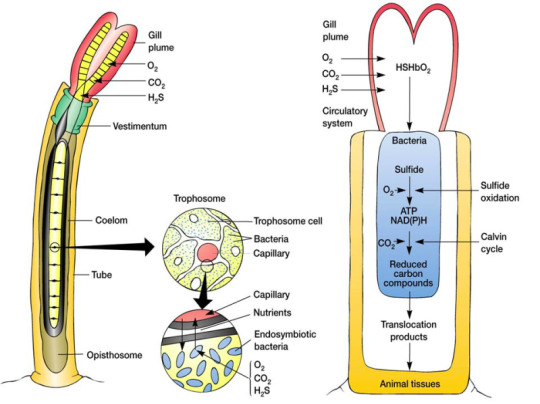
(Image ID: a scientific diagram of the internal anatomy of Riftia pachyptila. Of note is the section showing the trophosome, illustrating it as several yellow, spongy cells filled with bacteria and fed by a capillary. End ID. Source)
The most famous of the tube worms is Riftia pachyptila, which you will recognize if you have ever seen a documentary about the deep sea. They're the ones that look like giant tubes of lipstick. These are the most studied of the Siboglinids and live around hydrothermal vents in the deep pacific ocean. Hydrothermal vents are places on the seafloor where water underground is heated by geothermal activity in the Earth's mantle and then released into the water column, often carrying with it chemicals from deeper in the planet. These vents are hotspots of biodiversity in the deep sea and are hypothesized to play a major role in the origin of life. These ecosystems are among the only ones on the planet where the primary source of energy is not sunlight via photosynthesizing organisms. Instead, chemosynthetic bacteria forms the base of the trophic web, generating energy from the heat and chemicals released by the vents. Riftia requires vents which release sulfur into the water and blanket vents with the right conditions all throughout the Pacific. The lifestyle clearly works for them as they have the fastest grown rate of any marine animal. They can go from a larva to a sexually mature adult of 1.5 meters (4.9 ft) long in 2 years. These worms can reach 3 meters in length (9.75 ft) long, but only get to about 4 cm (1.5 in) in diameter within the tube. When reproducing, males will release blobs of stuck-together sperm called spermatozeugmata that collectively swim towards female worms, entering the tube and seeking out the female's oviduct. The female then releases fertilized larvae into the water. These larvae usually spend a few days in the water column before settling down on the substrate and beginning growth into an adult. However, the larvae have been known to reach newly-formed hot vents up to 200 kilometers away from their parent's vents. We don't know how the larvae find new sites to colonize or how long they can remain in the initial, motile state before succumbing to starvation as the larvae do not have digestive tracts and do not develop their internal bacterial colony until they settle down on the substrate. Once the larva does settle down, it develops its internal colony by intaking bacteria from the water using the plume. Riftia are some of the first organisms to colonize a new vent and play a major role in building that vent's ecosystem. Genetic tests show low genetic diversity amongst and between all colonies, which may be a result of how fast they colonize new vents and the fact that if a vent goes dormant or dies, all of the local worms will die with it.

(Image ID: a cluster of Rifita tubeworms, most of whom have their red, feathery plumes exposed. Some tubes do not have exposed plumes, indicating that either the worm has retracted into the tube or the worm has died. Several crabs are crawling on the tubes. End ID)
The other giant tube worm species I'm spotlighting is Lamellibrachia luymesi. These aren't as flamboyant as Riftia, but can get nearly as large (up to 3 meters) and also play a very important role in their ecosystems, though they are less studied. While Riftia likes it hot, Lamellibrachia is more chill. They live at cold seeps, places in the ocean where hydrogen sulfide and hydrocarbons like methane and oil seep out of the sea floor. Like Riftia, these worms depend entirely on an internal bacterial colony for their nutrition. Oxygen is intaken through the plume, but these worms can't get hydrogen sulfide the same way due to the different conditions. Instead, they absorb the sulfide through their roots. While the hot and cold worms absorb their hydrogen sulfide differently, they both have an adaptation to deal with it: specialized hemoglobin. Most forms of hemoglobin can't carry oxygen in the presence of hydrogen sulfide, which is a problem because that's the whole point of hemoglobin. The tube worms, who need to transport hydrogen sulfide, have specialized hemoglobin that seems to use zinc ions to allow for oxygen to bind to it anyway. The cold seep tube worms also excrete their waste products through the roots, returning it to the sediment. The intake of hydrogen sulfide and sequestering of the wast product in the roots and sediment lets the tube worms play an important role in the cold seep ecosystem. Them intaking the sulfide protects organisms who can't handle it as well and sequestering waste products also keeps it away from organisms who could be harmed by the chemicals in it. Hot vents are inherently unstable places. They are formed primarily in places where two tectonic plates are moving away from each other, exposing the planet's mantle. This exposed spot will eventually cool down and the hot vent will die off. Because of this, hot vent ecosystems grow fast and die young. Cold seeps by contrast are extremely stable and long-lasting. Lamellibrachia luymesi grow very slowly and can live for over 250 years. There's no need to hurry when your food comes out of the ground and won't be going anywhere for a very, very long time.

(Image ID: a colony of Lamellibrachia luymesi. Their tubes are more visibly segmented than those of Rifita, with the top of each segment being noticably wider than the base of the next. The tubes are a pale blue, but switch to white at 2 - 9 segments below the top. Many tubes have brown algae growing on them. The exposed plumes are short, red, and feathery. End ID)
#wet beast wednesday#tube worms#giant tube worms#Lamellibrachia luymesi#Riftia pachyptila#worm#wormblr#hydrothermal vents#cold seeps#marine biology#marine life#annelids#chemosynthesis#zoology#ecology#biology#long post#image described
106 notes
·
View notes
Text
My last post about life found under hydrothermal vents for me really interested in the prices behind chemosynthesis!
So I found this really helpful fact sheet from the US government's National Oceanic and Atmospheric Administration:
(it was free to find and download, so I assume I'm fine to share it here)


#marine biology#marine ecosystem#marine ecology#chemosynthesis#chemosynthetic bacteria#tube worms#marine mussels#mussel beds#ocean environment#weird environment#weird nature#protect the weird and wonderful#Ocean science#stem#ecological dynamics#photosynthesis#weird biology#biology#cool science#accessible science#open access
2 notes
·
View notes
Text
Fossil comic in the making

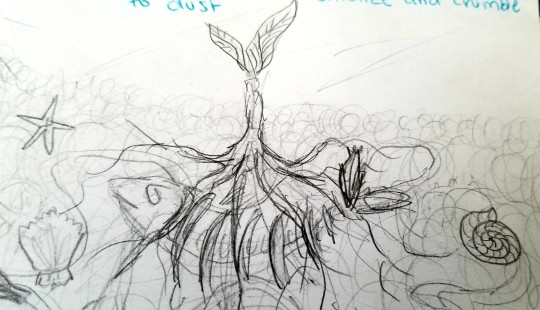






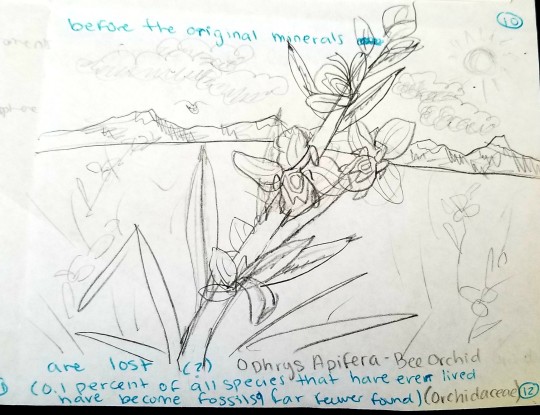
#fossils#sketch#whalefall#chemosynthesis#decomposition#wip#my art#im too excited so i had to share but it's Not Done#etc etc ♡
4 notes
·
View notes
Text
The Fairytale of Light
By Arjuwan Lakkdawala
Ink in the Internet
I'm a writer and an ardent reader, I have authored two fiction stories. Spellrainia, and The Chains. I've read a lot of fiction, science fiction, and fantasy books throughout my life, played videos games in the genre of fantasy as well. I'm now 42 years old, what I've learned at this point is that reality is way more stranger than fiction can ever be. And science is way more magical than any fantasy.
I often hear fans of the genre of fantasy claim that it's so magical, that the authors' imaginations are incredible. I have myself sang praises of C.S. Lewis (The Chronicles of Narnia). And Lewis Carroll (Alice in Wonderland) to name a few of the luminaries of the classics.
And they are deserving of the praise. However, I was not prepared for what I was going to discover as I made my transition from fantasy fiction to mainly science reading. Before I get into that I must praise science fiction writer Jules Verne (Twenty Thousand Leagues under the Sea, and many other fantastic books) who really drew a line that connected the magic of science with fantasy in a way I don't think any writer has been able to accomplish after him.
With that said when it comes to fantasy I think I can sum up the premise of it in mentioning a few characters and things. Boy/Girl on quest/adventure, dragons, griffins, unicorns, invisibility cloaks, wands, fairies, wizards/witches, school of magic, and I think we are basically done.
What we truly see in these types of stories is not the unthinkable or a challenge to the intellect. They are aesthetic to the mind and are hopes of what we cannot do but would be so wonderful if we could.
After my two books my interest had completely turned towards becoming a scholar of the sciences. I'm an aspiring scientist. I may never get the title but I will my entire life pursue independent research to educate myself and teach whatever I learn by writing articles.
Having an inquisitive mind that is inclined towards healthy curiosity like the universe is a sophisticated trait to have instead of gossip.
Science has stunned me because I have never read anything in fantasy or fiction that goes beyond what would be considered unthinkable. In science I have truly found the unthinkable and the unimaginable, and it took years for many scientists to each pick up where the other had left off, after no less than a lifetime of research and study.
So I cannot state enough how valuable is the information and knowledge that has accumulated in our scientific database. We are so fortunate that the Internet gives us access to so much of these treasures.
Please excuse my mini intro I just had to express how amazed I am and how fortunate I feel and grateful to be able to learn and write.
When I think about the world needless to say there is so much to think about, and one cannot think of everything at once. We have to breakdown the pictures and study the marvels of science one subject at a time.
In this article I want to focus on light. This simple bright thing is infinitely complex and has many forms. Even in this era scientists don't fully understand it.
So let us start with some simple questions: What is light? What was the first light in our observable universe?
In basic quantum theory light is electromagnetism or we can say packets of energy called photons.
There is light we can see and light we cannot see. The visibility region of light depends on its wavelength. Typically the human eye can see light between the wavelengths of 388 to 700 nanometers. We cannot see light which is in the longer wavelength region known as infrared region, and we cannot see light in the shorter wavelength region known as ultraviolet region.
We might think that the first light in our universe started with the Big Bang (a leading theory). Because we intuitively think of the Big Bang as an explosion when it's a sudden expansion of the universe at speeds faster than light.
Albert Einstein had said that nothing in the universe can travel faster than light, that however does not include the universe itself.
I'll explain why the Big Bang could not have been bright according to the science. An example that is usually given is that it was foggy like a cloud. When we see a cloud we can only see the surface where the light was last scattered, the water molecules in the cloud disperse light.
The Big Bang had a temperature that was so high that light couldn't travel from it into the universe. It took 300,000 years for it to cool down enough for the first light - the afterglow to spread in the universe. This light is known as the Cosmic Microwave Background radiation. It is everywhere and if you turn on the TV without cable the static that you see is the signal of the CMB.
We cannot see this light glowing because as light travels vast distances it gets stretched and this reduces its brightness. However the CMB is a very valuable phenomena as it carries with it information from the birth of our universe.
Regarding the Big Bang theory there is another fascinating theory attached to it, and that is the Multiverse. Scientists agree that the model of the Big Bang could allow for the possibility of Multiverses.
What is the theory of the Multiverse?
That when the cosmic inflation happened many universes were formed as bubbles, and our universe is in one of these bubbles and there are other universes in other bubbles, and each universe might have its own laws of physics.
Light is also known to be a colourful thing. Take the rainbow for example after the rain or when we see it through a prism. From a fantasy point of view the rainbow will always remind me of the animated series Rainbow Brite.
The rainbow scientifically is equally fascinating. As I saw on an episode of Be Smart recently (Youtube), the rainbow has streaks of dark lines, the missing light is due to the interactions of the photons with elements on the surface of the sun and in Earth's atmosphere. As the photons travel the electrons they bump into absorb bits of light changing the energy of the electrons.
In fact scientists can know which elements light has interacted with by the missing light on an Absorbtion Spectrum, when light passes through a prism. This is so useful since we cannot take samples from the sun to know what's in it, but the light coming from it can reveal the elements in it. Even the Mars Curiosity Rover uses it to discover elements on Mars. There are prints of elements from on the sun that haven't been identified, it could be because they don't exist on Earth.
I'm speaking in brief terms about light in this article, because I'm myself still learning about it.
So what does light do apart from making things visible?
A question that has deeply intrigued me is does light have the ability to move things? Can it bring physical change?
I think the first thought that would come to mind is photosynthesis. The dominant source of metabolism on Earth. But before I get into how light effects Earth let us think about it in the universe. It is said that Earth was seeded with the building blocks of life by many supernovae that exploded, they unlike the Big Bang where bright.
The first stars formed probably from hydrogen and helium, and little amounts of lithium, and then heavy elements that life on Earth depends on were formed from these.
Example of heavy elements:
Carbon, nitrogen, oxygen, phosphorous. Heavy elements are supposed to have an atomic number that is greater than 92.
Now let us think about how light effects Earth.
What is photosynthesis?
It is a process in which most plants absorb sunlight and with water make oxygen, and chemical energy stored in glucose. Herbivores need plants to get their energy, and carnivores eat herbivores and this sustains the circle of life on Earth.
Plants, algea, and some types of bacteria can do photosynthesis.
Then there is chemosynthesis which doesn't need sunlight.
It occurs in bacteria and other microorganisms in oceanic or inland waters.
It is basically a process in which organic matter (energy for the microorganism) is made from inorganic matter like hydrogen or hygrogen sulfide.
Speaking of microorganisms I think at this point much like speculation about the start of our universe, we can speculate about the start of life on Earth.
First I would need here to explain that inorganic matter and organic matter is the different assortment of atoms. Chemically many types of organic matter can be made from inorganic matter with the right type of natural environment.
So in speculation perhaps the start of life on Earth was from inorganic matter that joined to make H2O (water), heat cycles warmed and cooled that water and radiation one of the forms of light introduced elements and maybe even helped in the configuration of atoms and molecules in the water that become the appropriate environment for the first life form to appear. I say speculation because like the Big Bang no one knows how life started on Earth and why we haven't detected any form of it elsewhere in our Solar System, despite there being frozen water on other planets and moons.
Scientists have still not figured out consciousness or animal instincts or what is a soul.
Astrobiologist look for extraterrestrial life by studying matter in simulation of different environments that could be in space or other planets. While in the past it was mainly considered impossible for life to exist in space, recent studies have shown that there are microorganisms that can survive the journey through space. It is speculated that maybe microorganisms were introduced to Earth via comets or meteorites.
In an article on Neuroscience news.com posted on 16, Oct 2023.
It says: "Scientists from top Institutions describe a groundbreaking Discovery: The Missing Law of Nature."
The study has been titled: 'Law of Increasing Functional Information.'
It says that evolution is not something that can only happen in living systems, but can extend to atoms, stars, and minerals.
The study says that when configuration happens in these inorganic systems that increases functionality it is evolution. But what are the forces behind the configuration? The article states many physics phenomena like electromagnetism among other things.
Another discovery that I found interesting is posted on 12, October 2023 on Physics.org from the Minnesota University. The article is titled: "Surprising Discovery Shows that Electron Beam Radiation can Repair Nanostructures." The article says the discovery was made by accident when crystals were being studied for cracks in them, but the beam repaired the cracks when the atoms by themselves under the affect of the beam filled the cracks.
So this discovery with what we learned about the missing light in rainbows tells us that photons interact with electrons, and it is scientifically an established fact. I know in this study it was a beam of electrons but as radiation. Now photons and electrons are known to behave like waves and particles under specific conditions. This nature of photons is called wave-particle duality.
As I said there is so much to study about any scientific subject. I'll end this article here with the mention of Solar Sails, which is the idea to use the momentum of light to propel spacecrafts through space at 10% the speed of light.
Copyright ©️ Arjuwan Lakkdawala 2023
Arjuwan Lakkdawala is an author and independent journalist. Twitter/Instagram: Spellrainia
email: [email protected]
Sources: Photosynthesis - National Geogrphic
Extreme Tech - The Sun's rainbow why are there so many colours missing
By Sebastian Anthony October 2, 2013
NASA - A foggy universe...origin of the microwave background
NOAA Oceanic Explorations - What is the difference between photosynthesis and chemosynthesis?
Biology Online - Chemosynthesis
ESA - Cosmic Microwave Background (CMB) radiation
Space.com - Our Universe May Exist in a Multiverse, Cosmic Inflation Discovery Suggests
By Miriam Kramer
published March 18, 2014
Space.com - What is the cosmic microwave background?
By Elizabeth Howell, Daisy Dobrijevic
published January 28, 2022
Space.com - What is the Big Bang Theory?
By Andrew May, Elizabeth Howell
last updated July 26, 2023
Planck Satellite - UK Outreach Site - Cosmic Microwave Background
Webb Space Telescope - What Were the First Stars Like?
Short answer: We don’t really know.
Stanford University - Interactions of Photons With Matter
Nagwa - Question Video: Describing the Electron According to Modern Atomic Theory Chemistry
ESA - Energy=light=radiation=temperature
Lawrence Livermore National Laboratory - Discovery of Elements 113 and 115
Konica Minolta - Precise Colour Communication
Physics.org - When was the first light in the universe?
by Fraser Cain , Universe Today
Neuroscience news.com - Unveiling Nature’s Missing Law: Evolution Beyond Biology
Featured Neuroscience
·October 16, 2023
Britannica - Matter Rays
Science Direct - Water Worlds in the Solar System
Planetary.org - What is Solar Sailing

#science#Arjuwan Lakkdawala#ink in the Internet#physics#photosynthesis#chemosynthesis#radiation#light#fairytale#jules verne#c.s. lewis#Lewis carroll#alice in wonderland#narnia#rainbow#the law of increasing functional information#discovery
1 note
·
View note
Text
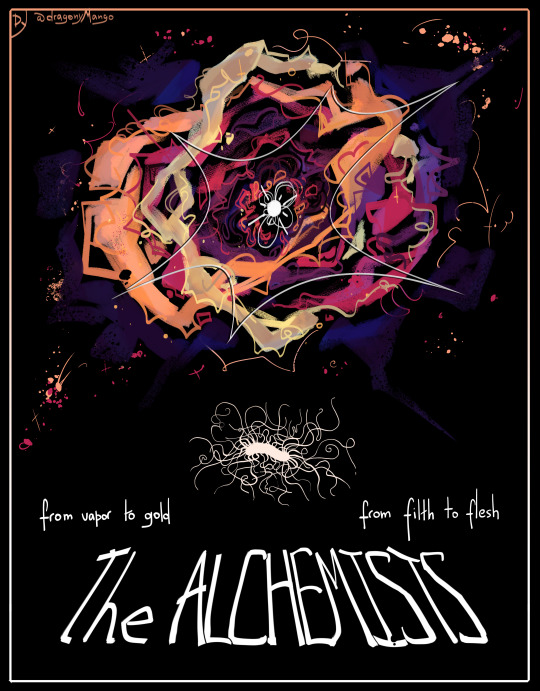
to the creators of what me call normal,
the forces too titanic and too small to comprehend
siblings of creation
#had this idea in my brain for a few years#and after this semester i needed to put it on paper#oh the structures so titanic and so imperceptible by which our stones are created and by which they turn to life#or the connection between chemosynthesis and nuclear fusion#dy art
10 notes
·
View notes
Note
do you have any cool ocean words that could work as a name? deep sea related especially
funny enough I'm blanking really hard on that x) I think you'd be better off looking at deep sea organisms' scientific species name and coming up wth a derivative name, or seeing if other languages have names that relate to the sea/the abyss (abyss ones are not common i gotta say, ive looked)
#deep sea words are all like. hydrothermal vents. whalefalls. chemosynthesis. silt. etc etc#ask#anon
8 notes
·
View notes
Text
Go look at an hydrothermal vent and maybe you'll clam down
7 notes
·
View notes
Text
I wanna know whats the equivalent in non-stem fields to really specific fixtures on topics for example I saw the phrase "subseafloor microbial environments" in a paper and my knee-jerk reaction was to say, out loud, "oh HELL yeah"
#misc#also specific people that u end up thinking are the coolest bitches on the planet#eg: i think colleen cavanaugh is a girlboss and her early research on chemosynthesis is like#my go-to specific topic that i love
0 notes
Text

I've barely seen any yeti crab content on here and this is very disappointing because look at these fluffy little guys!!!
They live at deep-sea hydrothermal vents.
This means there's no photosynthesis where they are. SO WHAT DO THEY EAT????
They rely on chemosynthesis instead - i.e. types of bacteria which can create biomass (I feel like you can't create biomass? But I'm not sure what to call it so this is what we're going with!) without any sunlight necessary. They use chemicals from the hydrothermal vent. later edit: they produce energy
Best of all. They grow the bacteria on the fluff!! The fluff is a bacteria home!! And when the crabs need to eat they comb through the fluff and eat the bacteria.
They wave their claws around inside the hydrothermal vent because that is what is best for the bacteria, even though they risk getting burnt
There's a type of yeti crab which is called a Hoff Crab and it's named after David Hasselhoff because it has a hairy chest as demonstrated below
in conclusion they are very cool
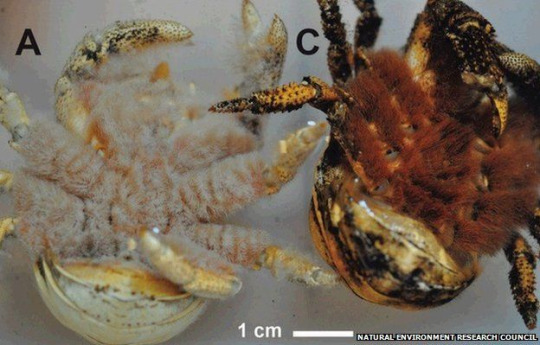
1K notes
·
View notes
Text
Spectember D29: Speculative Biome

Is not an oddity for geologists to look at some strange landscape formations, many caused by singular events or just by erosion, but the most particularly perplexing ones have been made by what is not considered to be a thing from this world...
North America seems to be dotted with dozens of these structures and the remains of already fallen ones, looking like gigantic towers of more than a kilometer in height, structured like a strange tree shaped form, it rises like a testament of the biggest terrestrial organism known, a monster tree made of stone and shaped by the millions of years of constant growth by part of a singular organism.
In Wyoming there is the most intact and oldest specimen of such beings, bein nicknamed Heaven’s Tower, unique megaorganisms formed by thousands of individual slime like organisms that behave like a stromatolite as it accumulate over layers over layers of sediment and material it built its structure, the way it do it seems to comprehend a system of vessels that transport the material from the terrain, often hollowing the terrain below forming a large cave chamber system that accumulate water and organic matter, preserve itself from erosion protected by a microbial layer product of the same organism. The tower seems to often renovate itself by the use of a special slime covering every century based on studies of change of texture and viscosity in the tower surface, but from what accounts on different expeditions into the inner cave system denote that the whole Tower formed dozens of millions of years ago, from mining expeditions around the chamber as well drilling in the main structure it was found it preserved a decent amount of data in the form of layers created by the accumulation of minerals by the slime into the main structure like a terrestrial stromatolite, this giving a possible date of the formation of the original tree around the late Eocene or early Oligocene.
As well seems to be every 5 to 10 million years there is a process that allow the introduction of surface fauna that always ends up into the lower chamber, to be eventually isolated which seems to last for few million years until there is a occurring a total extinction of the inner fauna, caused by the replacement and collapse of a old layer as its being replaced by a new one of almost 20 m of thickness, so far from fossil record the last breach occurred around the late Pliocene, isolating the fauna that lived upon that time.
The way one of the Heaven’s Tower specimen grow or originate is pretty much unknown for the very long span of time it takes to even start forming, is believe one of these might find a specific and rich place to feed its structure, more or less an old volcanic region and slowly accumulate to form the megastructure that feed symbiotically by chemosynthesis from the igneous rocks and photosynthesis, as well there has been identified fossil remains of older already fallen Towers that also expose similar patterns of growing. The Heaven’s Tower of Wyoming is the last intact structure as many seems to have been destroyed by the last ice age, and will take millions of years to recover, this itself is a testament of a paradoxical being that is still investigated, as this being for many accounts seems to not share any significant relationship of any living organisms.
276 notes
·
View notes
Text
This is so cool! Finding animal life beneath hydrothermal vents is incredible! Some of the things they found in the underwater cave systems in earth's volcanic crust include snails and tube worms. These tube worms alongside chemosynthetic bacteria, use the hydrogen sulphide in the chemical plumes from thermal vents by oxidising it to create energy and sugars to survive. How cool is that?!
I think this article also really demonstrates how important it is to conserve and protect lesser known ecosystems and species.
#protect the weird and wonderful#protect the ocean#ocean conservation#marine benthos#marine ecosystems#marine biology#aquatic ecology#aquatic creatures#ecology and conservation#marine ecology#deep sea#deep sea mining#deep sea creatures#deep sea conservation#Ocean thermal vents#tube worms#chemosynthetic bacteria#chemosynthesis
4 notes
·
View notes
Note
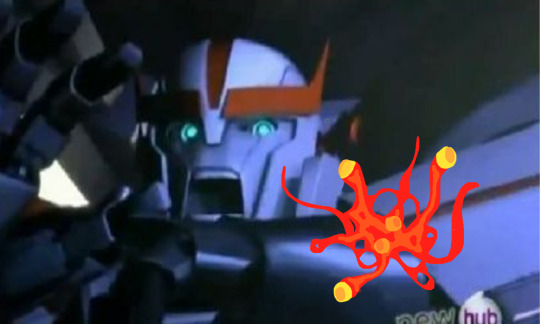
I evedently forgot how to draw using the pad, so have this terrible sketch instead for now.
anyway lore:
I imagine the blood mold would have five growth stages.
dormant spore. Its just a small dark red growth, looking vaguley like a seastar with too many arms. its very unoticeble in this stage and only syphons a minimal amount of energy from its host.
young mould. It progresses to this stage if its either attached to a optimal host species or a dormant spore attached to a suboptimal host species detects its host being invaded by another parasite. It gains basic sentience during this stage and acts agressivley towards any potential treats.
adolecent growth. As it grows it splits into many interconected pieces, each having its own set of eyes and operating on a kind of hivemind if disconected from the original pice. at this stage it tends to focus on the habits and behaviors of its host species, adapting as well as it can to its host body structure and abilitys, integrading as smoothly as possible. If attached to a more inteligend species, it tends to get sassy at this point, it also starts picking up on its hosts emotions, wich can overwhelm it at times.
adult colonie. A large growth fully encompassing the space provided by the host species, this is generally as big as it can get if attached to a suboptimal host. It has now fully adapted to its hosts body and can make the best use of it when it comes to defending itself. it syphons as much energy from its host as it is able to do without causing harm, as well as begining to use photo- and chemosynthesis to produce and store extra energie wherever it can, both to sustain itself and its host if nesessary. it mellows out quite abit at this stage, leaving more of the general movement and activities up to its host, as well as exhibiting some of their personallity trates.
Mother colonie. A large colonie grown beond what its host can support. At this point the blood mold gives up its own live in favor of turning into a ticking time bomb, any energie stored is used to produce as many spores as possible before the mother colonie bursts, hurteling its contents into the atmosphere. if sutible hosts are nearby small pieces of the mother colonie may latch onto them and persist. it can not reach this stage if attached to a suboptimal host species.
I imagine it originating from a mostly organic planet and having adapted to infect cybernetic species later on, leaving cybertronians like ratchet as the aformentioned suboptimal host species.
It would adapt to the cybertronian ability to transform by ceperating the outer armor from the internals, leaving the mold as the only conection point, and creating a cell type that can harden on command. this would not inhibit the cybertronians ability to transform, but would allow the blood mold to open up the armor and expand in size along the transformation seams, protecting any newly exposes inner circutry with a thick layer of hardened gel, while streching out the limps and creating more spaces to observe and lash out from. its very sturdy like this and can use its stored energy to rapidly regrow lost tissue.
I think it would most likley remain compliant with optimus up until it reaches the adult colonie stage, at wich point it would pick up on ratchets personallity and become defiant. it now packs enough of a punch to hold its own against optimus and bumblebee, provided it has stored enough energie to shrug off any damage dealt to it.
Though i could also see it get hit with ratchets fear and worrie during the adolecent growth stage and decide that optimus is too much of a threat to remain around, instead taking its chances at fighting the smaller bumblebee after making a run for it.
i could also see it forefitting its control over ratchet entirely, in favor of hiding so its host could be accepted by a more protective force such as megatron and his army. this has great angst potential when sooner or later somebody finds out.
i also love the way you made it speak. it would absolutley only comunicate in broken statements and incomplete scentences. also alot of hissing in displeasure. it would be completley apathetic to anything that doesnt concern its host or the rival parasite species. but it would absolutley try to compfort ratchet once it can sense his emotions, stress isn´t good for its host after all.
thats all i got for now, enjoy! :3
This is FABULOUS lore. I will apply this in your request friend :)
I love the idea of the blood mold as a whole. I have a thousand and one ways this could be incorporated into the Pretender au. Such a fun concept, especially when pitted against its arguably more successful counterparts.
32 notes
·
View notes
Text
❅MCU Jotun Headcanons❅
in honor of @jotun-design-party by magpiemurder. I had been looking forward to this contest for several months, but i have not been able to do anything for it and i doubt i will magically be able to do something and submit it by the time the deadline roles around (which is in like less than a week). This makes me sad, especially since i was something i was actually looking forward to participating in (and for such a long time) :(.
but anyways. headcanons instead, i suppose:
(also these are not very organized so have fun with that)
while jotuns do have extremly low body temperatures, the "frost-bite" affect you see them inflict in Thor 2011 is not because of that. Instead, it is due to a residue on their skin (like poison dart frogs).
Unlike poison dart frogs, however, the residue doesn't just stay on their skin 24/7. Rather, it secretes out of their pores
When jotuns are young, it secretes automatically when they feel scared/threatened (or exhibit other strong emotions), but as they get older they learn how to control it and can do it on command (and also keep it from happening). (<- my reasoning for why loki's cloths froze and chipped away the first time but not the second)(sort of)
the blocky/chunky/heavy type architecture you see is because it is sturdy and can survive blizzards/other harsh elements
based off of what odin said in his monologue, jotunheim is "cold dark and barren," so the next few sort of are in line with that, but who know if he was actually telling the truth lol
not a lot of biodiversity (and FAR less plants than animals) :/ (i actually think it'd be cool to have a frozen planet teeming with life, but again, prev reason...)
since it's hard for plants to grow in such cold/dark places (lack of sun, dirt/nurtients, nutrient flow, liquid water, etc), the only "normal" plants you see are in the north pole (which is warmer, and is sort of a tundra type biome)(most plants typically aren't even there year-round). Everywhere else, plants have to find other ways to survive. Since photosynthesis isn't really a viable option (though there are a rare few that do!), most plants either perform chemosynthesis (x) or are parasitic (x). This also means that lots of plants are a ghostly white, rather than green (no chlorophyll).
licehen is less common than here, but can be found on occasion (and can be eaten)
mushrooms are relatively common, however (and unlike our mushrooms, can survive alright in the cold)
There isn't really any liquid water (and what little is seasonal), yet there are still life in the frozen water. There is a species of fish that produces so much warmth that the ice around them melts, and they swim through their self-made streams (that freeze back up once they've left). These fish eat snow/ice algae and ice worms (the algae and worms are actually real things in real life btw) (x) (x)
I thought it was interesting in the film how it's such a cold planet but nothing seemed to have fur, just skin... perhaps there are furred creatures, though, and they simply live in other regions. Id say the south pole, maybe the north pole, and and/or an isolated bit of land ("continent") on the opposite side of the planet. Long wooly fur. Horns. These creatures evolved to be warm on the cold, and the creatures we saw in the film simply evolved to not need to be warm at all.
the clothing you see the jotnar wear in the Thor 2011 is not their usual wear, it is their wartime/battle clothing.
This is because even though they are no longer literally warring, odin's treaty (aka sentence to slow genocide) was a "war against their people." As such, the majority of the jotnar choose to wear the wartime clothing until they all die out (as sort of a statement against odin/asgard's colonialism/imperialism)
(also probably "honor" or other culture type situation)
War clothing components:
Shaved Head: The jotnar typically grow their hair out long in times of peace, but shave it when times of war arise. In some regions, it is only those that go to battle that shave it, but in other regions all people shave it
Loincloth: made from Frost Beast leather. While frost beast hide is blue, the process to turn it into leather gives it a green tone (and is also becomes more rubbery than our leather). The sewing pattern of the loincloth itself typically is what gives it creative design, rather than having added embroidery/beading/embossing/etc.
Misc Decorations:
small decorative pieces are stuck directly to the skin via freezing water or using sticky sap-like substances. The most common places for these decorations are the head, upper chest, and shoulders. These pieces serve no protective functions, save the ones that are used to cover the nipples of jotuns with breasts (just around the nipple and areola, not the full breast).
small bracers, pauldrons, and greaves are sometimes worn.
Never shoes, pants/bottoms, shirts/tops.
Clothing should be NON besides the loincloth, and armour should be minimal and mainly decorative.
Decorative pieces are typically also made of frost beast leather. Metal is not usually used on jotunheim, because it is far to cold to melt anything (and to actually start a fire that hot would cause massive environmental damage). The only metal typically used it mercury, because it has such a low melting point (-38.829° C/-37.892° F). Interestingly, leather and mercury (and ice) are the only materials used in war clothing, not bone, even though bone is used in non-wartime clothing.
Overall Scarcity of clothing: While the jotnar don't typically get cold, they do want protection from cutting winds, ice, and snow (blizzards are strong enough that the snow can cause cuts/"burns"). As such, having such scarcity of clothing is a statement of strength/bravery and used to deter the enemy.
regular cloths cover more (to protect from the elements, not provide warmth). Leather, metal, fur, and fabric woven from wool are used. Bone and metal are also used. Typical colours would be the familiar green, dusty purple, grey/brown/black/white (fur colours), and some blue
piercings and gauging are popular, even though not always practical. Most popular places to pierce/gauge are the ears and nose.
Hair texture in the region where we visited in thor 2011 is typically smooth and silky (like lokis), but other hair textures (curly, coily) exist in different areas. All hair is typically raven-black, unless the jotun is albino (in which case, it would be white)
Unsure of:
i feel like jotuns would be carnivores, but at the same time i feel like loki would enjoy more vegetarian/pescatarian food options, so idk what to think :|
I feel like the casket of ancient winters would be taken straight from the core of the planet, and is super condensed ice and seiðr, and that's why taking it away ruined the planet
(but then that poses other questions, like why would they mine something and keep it as an artifact? were there warring tribes and they wanted to get ahead? did some foreign colonial/imperial power mine it and for their own gain and the jotuns only got it back later?)
also the other possibility is that the casket has to do with something of the passing of ancestors/powerful jotuns of the past and their seiðr or souls or smth is in it (and that would give more power to the "casket" part)
i actually i can think of a lot of things... but those are my main two for the casket
wait why are my indented bullet points not working anymore what!!! this was more neat-looking i swear
jotun breast milk does not have lactose. i will not elaborate.
ok those are all i can think of right now
(bonus loki-specific one: the reason he is so small was because his mom got stuck by lightning when she was pregnant)
#seriously tho i'm sad about the contest :(#:(((#unityrain.txt#mcu jotunheim#jotunheim#jotun#jotnar#jotun loki#mcu loki#loki#worldbuilding#mcu asgard#headcanon#headcanons#long post
20 notes
·
View notes
Text
sea monster stuff people didn't ask for underneath the read more
the smaller Firths, Corsols, are around 5-4'ish feet long, around 100 pounds. they're very bright and colorful- usually having all kinds of different patterns. they enjoy eating crustaceans, which they crack open and eat on rocks. they use their little grabby hands to smash them open like otters. Corsols have poisonous barbs that lay flat on their back. they flare up whenever the Corsols feel threatened. they have a mutualist relationship with Firths. Corsols are very friendly to their bigger brothers/sister, and they're often found playing together
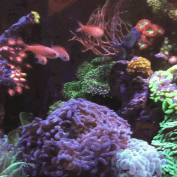
another species of sea monster is the Pyroclacks. they're around 7-6'ish feet long, around 300 pounds. (i don't have any good names for them) they live around hydrothermal vents, mostly thriving off creatures who use chemosynthesis- indirectly getting the same outcome. they are usually black or deep in color, but have a long "whisker" on either side of their head. they use these bioluminescent whiskers to attract mates. they look like these Blood Belly Comb Jellies
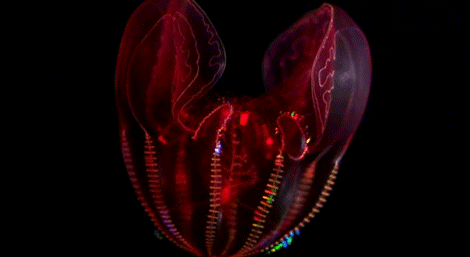
9 notes
·
View notes
Note
Begging you to tell us also about when oxygen nearly sterilized the planet. You have a hypnotic writing style
Stop, please! I'm married!
Hokay, so, a fucktillion years ago (well, between 4 and 2.5 billion years, but at a certain point of imponderability all those big numbers look the same, so let's stick with the funny one, yeah?) nothing alive on earth had ever heard of "free elemental oxygen". They metabolized food anaerobically - by fermentation or CrP hydrolysis or maybe even simple glycolysis, as was the style at the time. The specifics are a bit conjectural, since microbial membrane proteins don't fossilize terribly well, but we have enough anaerobes kicking around to get an idea of what our ancestors probably had to work with.

Not this kind of fermentation, but it gives you an idea of what's up. Thanks, Wikimedia Commons!
Now, breaking food down into energy is one thing, but what about getting it in the first place? Well, the best way is to borrow some energy from the environment and use it to "cook" simple chemicals into more complex ones you can break back down. Basically translating environmental energy you can't use into a form which you can. The earliest way to do this was probably a form of chemosynthesis.
I won't bore you with the details, but this early chemosynthesis would have been...weird. The important part is that the process probably took hydrogen sulfide and carbon dioxide, broke them apart, and recombined the Choice Bits into sugar. Unfortunately, that process would have needed the Weird Earth Chemicals (energy source) and the stupid-high temperatures belching out of hydrothermal vents in order to work, and even then it was slow as hell! There was room for improvement
At some point, some plucky little microbe went "hey, if I use light to excite a pigment, I can use the electrons shot off that pigment to blast hydrogen sulfide and carbon dioxide apart instead of waiting on Weird Hot Slow Earth Chemicals!" This was huge. The fundamental principle was still basically the same: 12H2S + 6CO2 -> C6H12O6 + 12S + 6H20, but it was faster and easier than ever! Plus it made the earth purple!
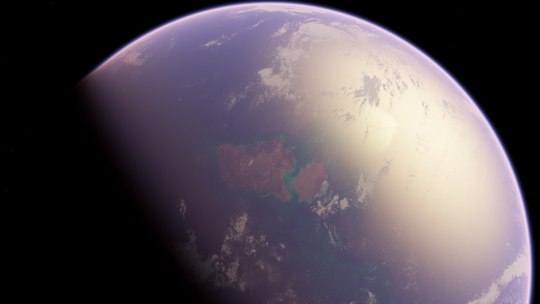
There's a joke about Prince in here, I just know it. Thanks, Wikimedia Commons!
But, as is the running theme...we can do better.
Around 2.5 billion years ago, a tiny, subtle mutation arose. A minute riff on the existing form of photosynthesis played out in the genome of one lineage of microbe or another. One that was terribly advantageous: instead of using hydrogen sulfide - which needs to come from marine volcanoes or other microbes' waste - as a hydrogen source, these guys could use water. You know, the stuff that's everywhere. It was H U G E. These new cyanobacteria (so-called because instead of being purple, they're...well...cyan) rapidly began to dominate the marine microbial ecosystem.
However, this nifty new metabolism had a little problem: the byproduct of mashing water and carbon dioxide into sugar was oxygen.
If you've ever seen that post about how "oxygen is secretly killing us", know that it's not a joke. Oxygen is so horrifically electronegative that it freely oxidizes (hence the name) just about anything with an even remotely positive charge. If you're alive, uncontrolled oxidation is very very bad. And in a geological eyeblink, global oxygen levels went from this:

To THIS:

AAAAAAAAAAAAAAAAAAAAAAAAAA
This may not look like much, but if you've ever spritzed a little Barkeeper's Friend into a 100-gallon fishtank by accident while cleaning up the marine biology classroom you're interning for, you know just how dangerous a little of something can be (and yes, I still feel absolutely terrible, don't @ me). It's hard to quantify because...you know...bacteria don't fossilize too good...but based on isotopic analysis of Archaean sedimentary rock and paleontological technomagic, it's estimated that the oxygenation of the atmosphere killed off some 80% of Earth's microbial biomass. It was that bad.

POV: you're in the Archaean and about to do a war crime.
Eventually , the descendants of the oxygen-tolerant microbes evolved the ability to harness oxygen's horrific destructive power to help them metabolize food more efficiently. WAY more efficiently. Instead of making sugar from water and CO2 and fermenting it to alcohol, they could use oxygen to break that sugar back down into water and CO2. That's an absolutely ridiculous amount of energy. Life on earth sped the FUCK UP. Everything started living, eating, reproducing, and dying at a more rapid pace than ever, but untold microbial biodiversity was lost forever.
If you take one thing away from this post or my Methanosarcina addition to the Lystrosaurus post, let it be this: If you're an organism on earth who enjoys being not-extinct, DON'T FUCK WITH THE ATMOSPHERE.
#paleobiology#microbiology#biochemistry#I probably got a lot wrong#but that's the jist of it#rambling#oxygen crisis#great oxidation event
16 notes
·
View notes